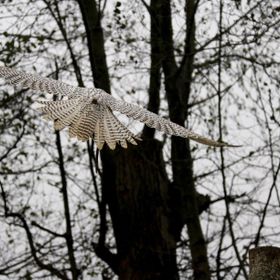
caitlinjones00
FollowViews
319
Likes
Awards
Well Done
Peer Award
Superb Composition
Absolute Masterpiece
Outstanding Creativity
Superior Skill
Magnificent Capture
Top Choice
Categories
Same photographer See allBehind The Lens
Discover more photos See all
Behind The Lens
Location
This photo was taken at Millets Farm in the UK during a falconry demonstration of several types of birds of prey. It was taken in late December and so the weather was windy and cold and not suitable for many of the birds however the Gyr Saker Falcon (pictured), as the largest type of falcon, was still able to fly spectacularly.Time
30th December 14:18 - after a post christmas catch up lunch with extended family.Lighting
The photo is of a Gyr-Saker Falcon hybrid in flight. The snowy white feathers are those of the Gyrfalcon which is a huge beautiful bird that originates from the arctic coast so I wanted the lighting to show those cold themes but without completely washing out the photo.Equipment
Canon EOS 760D with a Canon EF-S 18-200mm lensInspiration
During the flight demonstration, the falconer was telling us about how Gyr Saker Falcons originally being used in Saudi Arabia as they are a cross between Gyr Falcons (The largest falcons in the world) and Saker Falcons (The native falcon to Arabia). Falconry is believed by many to have been a part of Arabian Bedouin life for thousands of years. It was a popular past time for the rich who, much like having a bigger fancier sword or better look horse in the medieval times in England, would use the size, speed and beauty of their falcons to show others how rich and important they were. As Gyr Falcons are the largest in the world this was desirable to them. Gyr Falcons are native to the arctic circle though and so could not survive in Arabian heat. Saker Falcons however are native to Arabia and valued for their incredible beauty. Combining these two species creates a new species of a large, beautiful bird with the ability to survive in hot and cold climates. This detail and insight into the history of the Gyr Saker Falcon made me want to capture it in flight to show it's clean, wonderful beauty.Editing
--In my camera bag
I am only just starting out and so generally only have my camera and it's lens.Feedback
At a falconry demonstration, the falconer will often talk you through exactly what they're going to get the bird to do and so it is often easy to know what is about to happen and when. This makes it much easier to know where the bird is about to go so you can be ready to get the photos you want. But although predicting their movements is easy, it's hard to know how fast they're going to take-off or swoop down and so it is difficult to get the angles and focus and white balance exactly how you want it. Because of this it's easy to be let down when you look back at a photo and part of the wing is not in frame or they're just off focus. By taking multiple photos at once at a fast shutter speed as well as regularly checking back at the photos you have taken to see if there is any obvious quick fix you can do to make the next ones better, you minimise the chance of being disappointed, but also quickly begin to teach yourself which methods are working in the environment you're in, and which aren't. Photographing animals, and specifically birds is going to be a different experience each time because of the number of variables you have to take into account, but by spending a long time getting used to the conditions you can easily become familiar with your surroundings, and by frequently going to falconry demonstrations or something similar you begin to get used to knowing which birds do what and how the show is going to pan out and thus you can position yourself to get the best photos.











































